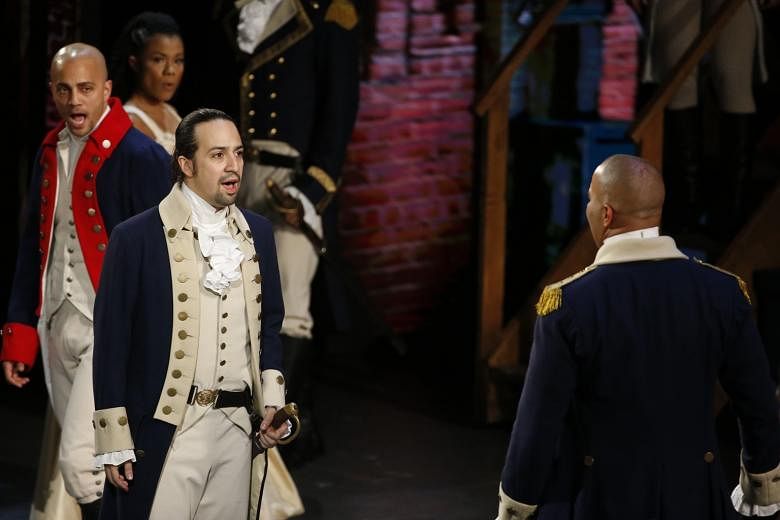On July 9, Lin-Manuel Miranda, founding father of Hamilton, took his final bow in the title role of his hit Broadway musical.
Other original cast members, such as Leslie Odom Jr, who played Aaron Burr, also left the show after that performance and Daveed Diggs took his final bow within days.
But the change was notable for reasons that went beyond casting: It could well have been the high- water mark for demand for Hamilton tickets - and for profits reaped by scalpers who make up part of what is known as the secondary market in ticket sales.
For most of May, the median price of a ticket on the secondary market was about US$850 (S$1,140).
Between the Tony Awards and the July 9 performances, it pushed towards US$1,600.
Before Miranda's announcement of his departure, ticket holders were offering a seat for the July 9 performance at an average of US$2,700. With the news of his exit, the average asking price quickly climbed to US$10,900.
Mind you, the average face value of a Hamilton ticket was US$189.
The good news for fans of the show: With the cast departures, the resale price has dropped significantly and levelled off around US$700 a seat. And they can go much lower.
In the week after Miranda's departure, tickets were available for US$300 or less within the last 30 minutes before curtain.
Definitive sales information is elusive because scalping operates in the shadows.
So to figure out just how much scalpers were making from Hamilton, we created a database by collecting publicly available information on ticket prices on secondary market listings. We watched the price history for each performance for days, weeks and, in some cases, even months.
What we found was that scalpers took in more than US$15.5 million from the 100 performances before Miranda's final show, the bulk of it (US$10.5 million) coming from the 32 performances between the June 12 Tony Awards - where Hamilton won 11 statues - and July 9.
The Hamilton producers do well on the musical, which generates net profits of about US$600,000 a week. For those same 32 performances, they made around US$2.7 million in profit, but less, we estimate, than the profits cleared by the scalpers.
Scalping can be explained with high-school textbook economics. When ticket prices are too low to balance demand against the supply of seats, any person holding a ticket can find buyers willing to pay more than its face value.
Increasingly, that ticket holder is a person employing sophisticated software, a so-called ticket bot, to buy a huge number of tickets moments after the theatre releases them.
In the time a human buyer can find the calendar feature on a ticket site, a scalper's network of hundreds of bots has already bought the maximum limit of tickets for multiple days of shows.
The Internet gives scalpers greater reach into ticket purchasing.
The professional tier of scalpers buys and sells thousands of tickets a year and leverages millions of dollars of inventory.
Some use custom-written software to manage their inventories and adjust their prices based on real-time market analysis, much like traders on Wall Street.
Because the secondary market is scattered across dozens of websites and storefront services, its size is hard to establish.
For Hamilton, websites such as StubHub, SeatGeek and Ticketmaster relist, on average, more than 35 per cent of the 1,321 seats sold in the Richard Rodgers Theatre for each of the eight performances a week.
Such a strong secondary market is relatively new to Broadway, but painfully familiar to sports fans and concertgoers.
Scalpers have contributed significantly to inflated resale prices for high-profile events such as the Super Bowl or Beyonce or Bruce Springsteen concerts.
Looking across nearly 100 days of performances - from early May to late July - we found the median resale ticket price was nearly US$1,120 a seat. By our analysis, scalpers were earning more than six times what they paid for their tickets.
To avoid detection, sophisticated scalpers use bots designed to resemble human buying patterns, although they use the websites far more efficiently than humans do. Bots do not click wrongly or need to use the delete key, though they may do that as well, to further obscure the evidence of a non-human purchase.
The masquerade is important because Hamilton cancels what it deems to be bulk-ticket purchases.
It is an uphill battle. Bot-driven ticket buying, illegal in New York since 2010, remains widespread. Networked bots can play a big role in distorting ticket prices, driving significant traffic on Ticketmaster.com, up to 90 per cent of ticket-purchasing activity at times.
But the producers have limited options for balancing supply and demand.
On the supply side, they are offering more seats and performances by opening productions of Hamilton in Chicago next month, as well as touring productions starting in San Francisco next year and Seattle in 2018.
On the demand side, raising the theatre take by about 30 per cent in New York may well help further dampen enthusiasm and at least make scalping less profitable.
Nonetheless, Hamilton remains one of the most expensive tickets in the history of Broadway.
NEW YORK TIMES

